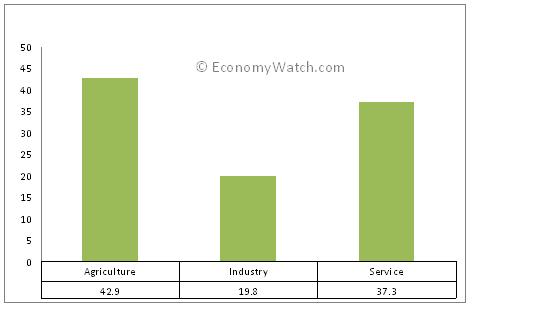Myanmar Economic Structure
Please note that we are not authorised to provide any investment advice. The content on this page is for information purposes only.
Rich in natural resources, Burma is a poor country economically. It is suffering from rural poverty, with 32.7% of the population living below the poverty line. Poor government planning, inefficient economic policies, minimal foreign investment, a trade deficit and internal unrest contribute to Myanmar’s sluggish growth rate.
Rich in natural resources, Burma is a poor country economically. It is suffering from rural poverty, with 32.7% of the population living below the poverty line. Poor government planning, inefficient economic policies, minimal foreign investment, a trade deficit and internal unrest contribute to Myanmar’s sluggish growth rate. Although it has emerged as a natural gas exporter, Myanmar has witnessed a deterioration in its economic condition due to the fact that the nation is victim to the highest levels of corruption in the world (revealed by Transparency International in its 2007 Corruption Perceptions Index). The nation’s ample natural resources are largely exploited by its military leaders and their associates.[br]
The following serious macroeconomic imbalances are also to be blamed:
-
Fiscal deficits
-
Distorted interest rate regime
-
Rising inflation
-
Multiple official exchange rates (that lead to overvaluation of the Burmese kyat)
-
Unreliable statistics
-
Failure settle national accounts for the determination of a realistic GDP figure
-
Poor investment climate
GDP – composition by sector:

Myanmar Economic Structure: Division by Sectors
Myanmar’s economic structure can be divided into the following sectors:
Primary Sector: The agricultural sector provided employment to 70% of the country’s work force in 2001. Rice was the only major agricultural produce, covering, 60% of the total cultivated land area. If measured by weight, 97% of the total production is rice. Some other major agricultural products include beans, pulses, sugarcane, sesame, groundnut, teak, and fish. Myanmar’a government sees a lot of growth potential in this sector. For years, it has also lent money to farmers, although due to interest some do not find it interesting.[br]
Secondary Sector: Myanmar’s manufacturing sector is characterize by slow growth. Only 7% of the country’s workforce is engaged in the industrial sector (as of 2001). Industrial growth rate in 2009 was 0.2%. Petroleum, liquefied natural gas (LNG), and minerals are the major industries in the country. It has a wealth of gold, jade and gems, copper, tin and zinc. Tobacco is also produced on a large scale by government-owned factories as well as cottage industries. Some other industries include food and beverages, electronics, electrical products, steel processing, chemicals, garment, metal and machine products.
Tertiary Sector: With 23% of the labor working in the services sector (as of 2001), this sector remains weak in terms of growth. Socio-economic conditions and poor infrastructure have crippled Myanmar’s tourism industry, which used to contribute a significant share to the country’s GDP at one time. However, Myanmar is now participating in international travel trade shows and also encouraging domestic travel agencies, airlines and hotels to attract tourists. The banking sector is also suffering from tight controls that restrict the private sector’s access to formal credit.




